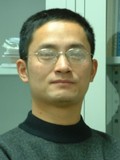Visiting Researchers
 |
Institute |
Graduate University of Chinese Academy of Science |
Title |
Associate Professor | |
Country |
China | |
Period of Stay |
2006/01/10 - 2006/09/09 | |
Research Theme |
Seismoligical study of the uppermost part of the lower mantle | |
Host Researcher |
Hitoshi KAWAKATSU |
I am Yuanze ZHOU, Dr., from College of Earth Sciences of Graduate University, Chinese Academy of Sciences. After geting Ph.D. on the mantle discontinuities in Peking University, China, I have been in the Graduate University for 3 years. It's my pleasure to have a chance to be at ERI, University of Tokyo to continue the research work on the Earth interior's structure with secondary phases.
You are welcome to contact me with emails: [yzzhou] AT [eri.u-tokyo.ac.jp; gucas.ac.cn].
From Jan. 9 to Sep. 9, I have been kindly invited and supported by the the Office of International Earthquake and Volcano Research Promotion, ERI and Prof. Kawakatsu from OHPC is my host professor.
My mainly work is on deep structure of Earth’s interior with seismic waveform data.
Firstly, I continued my previous work on the 660 km discontinuities. Prof. Kawakatsu gave me some suggestive ideas for confirming the possible SdP converted phases. Also I practiced the bootstrap technique for the slant stacking method under the suggestions from Prof. Kawakatsu, which is helpful for estimation of the noise level . After some modifications and considerations, I resubmitted the paper written in China to GRL and now got positive outcome.
Secondly, as suggested by Prof. Kawakatsu, I tried to study the existence of the discontinuities in the inner core by using the reflected phases of PKidiKP, where d is the depth below the Inner core mantle. With the data from Jarray, I found a new earthquake (2001-02-08 00:16:15.30, Lat:52.754o, Lon:153.812o, Dep: 436.8km, Mb:5.6) from the available data between 1996-2006 at northwest of Kuril Island whose waveform data from Jarray show clear PKiKP which means this earthquake gives strong reflections from inner core boundary and we may observe the weak reflect signals from the inner core interface(s). After collecting more waveform data from the hinet with the help of Prof. Kawakatsu, I selected high signal-to-noise-ratio(SNR) data with PKiKP and stacked with slant stack method for the bandpass windows of 0.8-4.0Hz and 0.5-1.0Hz. From stacking envelops related the reference PKiKP in 0.5-1.0Hz, we can find a clear sPKiKP and relative clear pPKiKP and based on these phases, some signals related to the inner core structure are observed. But, because of not large magnitude, the signals just can find above 2 standard deviation of noise level and no such signals can be observed in higher deviations. So it’s rather difficult to confirm whether the signals are the reflected phases from the inner core structure even they cannot be confused by the pPKiKP and sPKiKP. So now, more work on synthetic seismograms are still on running.
In the duration, I also spent some time to do the following work:
1. Being familiar the synthetic seismogram programs, which include the reflectivity method and generalized ray method(WKBJ);
2. Being familiar the retrieving waveform data from hinet and preprocessed with win32tools with much help from Dr. S. Watada;
3. Attending the Japan Geoscience Union Meeting 2006 supported by the International Office;
4. Attending some seminars on earthquake and the structure of the earth’s interior;
5. Attending the primary Japanese lessons.
Traveling around Tokyo and a short-period trip of Kyoto-Oosaka-Kobe-Nara make me know more about the Japanese people and culture, especially those different kinds of Japanese Jinjas and Buddhism temples.
My first abroad life is very exciting with the help from Prof. S. Okubo, T. Kato, H. Kawakatsu, W.K. Sun, as well as Ms. T. Watanabe, N. Matsushima, I Mie and Mr. K. Yokoyama. Mr. G. Y. Fu gave me much help and suggestions on living in Tokyo.
Thanks also due to Prof. Y.L. Shi and D.P. Wei at GUCAS who give me supports and encourages.
